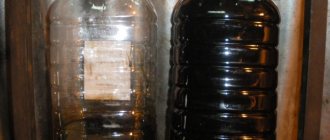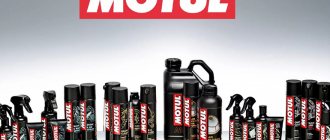What is oil used for?
Automotive oil ensures the proper functioning of various systems. It is used to reduce friction, cool, lubricate, transfer pressure to vehicle parts and components, and remove combustion products. The most difficult operating conditions occur with motor oils. They must not lose their properties in the event of instantaneous changes in thermal and mechanical loads, under the influence of atmospheric oxygen and aggressive substances resulting from incomplete combustion of fuel.
The oil creates an oil film on the surface of rubbing parts and reduces wear, protects against rust, and reduces the impact of chemically active components that arise during engine operation. By circulating in the engine crankcase, the oil provides heat removal, removes wear products (metal chips) from the contact zone of rubbing parts, and seals the gaps between the cylinder walls and piston group parts.
What is oil viscosity
Viscosity is the most important characteristic for motor oil, which changes depending on temperature. The oil should not be too viscous in cold weather so that the starter has the opportunity to turn the crankshaft and the oil pump has the opportunity to pump oil through the lubrication system. At high temperatures, the oil should not have low viscosity in order to create an oil film between the rubbing parts and provide the necessary pressure in the system.
Sulfated ash content
What determines the sulfate ash parameter
Sulfate ash content is the content in oil of various solid and inorganic compounds that are formed after combustion of the lubricant. Determined as a percentage of the total mass of the oil.
There are two concepts of ash content - base oil ash content and sulfate ash content. To explain it simply, the usual ash content indicates the purity of the base oil, that is, how much salts and non-combustible impurities are contained in the base itself without adding an additive package. Sulfate ash content is determined for ready-made oil with an added package of additives, and it determines the amount of additives and their composition, this applies to salts of sodium, potassium, phosphorus and other substances.
When considering the characteristics of an oil, the ash content must be as low as possible for it to be called quality. According to international requirements and standards, it should not exceed 2%.
Why is that? In any internal combustion engine, a certain amount of oil evaporates under the influence of high temperature, that is, it burns. This process leads to the fact that non-combustible impurities, which are always present in the oil, settle on the walls. That is, the higher the ash content of the oil, the more plaque there will be. Systems equipped with particulate filters are especially sensitive to high ash content; for them, only oils from the special LowSAPS category - low-ash oils - can be used.
How is the sulfate ash content of finished oil determined?
In the laboratory, oil is burned at a temperature of 775 degrees until solid residues form; it is this solid mass that is the same ash, non-combustible residues that settle on the walls of the engine and clog the exhaust gas cleaning system. The mass of residues is correlated with the amount of oil tested and the percentage is calculated.
If we talk about the ash content of a pure base, without additives, then it often does not exceed 0.005%, but in the finished oil we are talking about figures of 2%, this difference is made by the additives added to the oil. That is, we get the following picture: the “fatter” the additive package in the oil, the more ash there will be. So this indicator can be viewed in two ways. On the one hand, the oil must be clean and not leave deposits on the engine. On the other hand, high ash content indicates a rich additive package.
What does sulfate ash affect?
In addition to the fact that a high content of sulfated ash leads to a large amount of deposits inside the engine, it affects some other oil parameters. Ash content is directly related to the alkaline number of motor oil, which we will discuss below. The amount of ash is directly proportional to the amount of alkali, that is, the more ash, the more alkali and the higher the cleaning properties of oils.
The amount of ash deposits during combustion affects the flash point of the oil, which was already discussed above. This is especially noticeable in working out. Over time, additives burn out, and the less of them remain, the lower the flash point, that is, the performance of the oil decreases.
If we talk about the design of the car itself, then oils with a large amount of ash have a negative effect on the ignition system, make it difficult to start in cold weather, and contaminate the elements of the exhaust cleaning system - catalysts, particulate filters, EGR systems. Low ash oils, in turn, do not provide the necessary protection for loaded engines.
Classification of oils depending on the amount of sulfate ash
The ACEA classification pays great attention to the sulfate ash content of oils and even divides them into categories, depending on its content in the finished composition:
- Full Saps - full-ash lubricants, ash content is allowed within 1-1.1%.
- Mid Saps - medium ash lubricants, ash content allowed from 0.6 to 0.9%.
- Low Saps – low ash, less than 0.5%.
Manufacturers often place information on the oil canister about whether the oil belongs to a particular category.
Designation of motor oils according to the API standard
The API (American Petroleum Institute) standard specifies where the oil should be used. Consists of two Latin letters. The first letter S is a gasoline engine, C is a diesel engine. The second letter is the date of development of the car.
Gasoline engines:
- SC - cars that were produced before 1964;
- SD - cars that were produced 1964-1968;
- SE - copies that were produced in 1969-1972;
- SF - cars that were produced in the period 1973-1988;
- SG - cars developed in 1989-1994 for use in harsh conditions;
- SH - cars developed in 1995-1996 for harsh operating conditions;
- SJ - copies with a production date of 1997-2000, which have the best energy saving;
- SL - cars, with the beginning of production 2001-2003, and having an extended service life;
- SM - cars produced since 2004;
- SL+increased oxidation resistance.
For diesel engines:
- CB - cars manufactured before 1961, high sulfur content in fuel;
- CC - cars manufactured before 1983, operating in difficult conditions;
- CD - cars produced before 1990, which had to work in difficult conditions and a large amount of sulfur in the fuel;
- CE - cars manufactured before 1990 and the engine has a turbine;
- CF - cars produced since 1990, with a turbine;
- CG-4 - copies produced since 1994, with a turbine;
- CH-4 - cars manufactured in 1998, complying with toxicity standards applied in the USA;
- CI-4 - turbocharged cars with EGR valve;
- CI-4 plus - similar to the previous one, under high US toxicity standards.
Sulfur content
The amount of sulfur in fresh oil is determined as a mass fraction, that is, as a percentage. This indicator depends on the nature of the oil from which the base was prepared and on the quality of its purification. Modern refining methods make it possible to create oils with low sulfur content.
Based on the amount of sulfur in the analysis, you can determine the degree of base purification and the additive package used - calcium sulfonates or calcium salicylates. In the first case, sulfur will be up to 0.400%, in the second 0.200-0.260%. If sulfur is more than 0.500%, this most often indicates that the base contains mineral oil of the first group, most often found in semi-synthetics with high viscosity.
Kinematic and dynamic oil viscosity
To determine the quality of the oil, its kinematic and dynamic viscosity is determined.
Kinematic viscosity is an indicator of fluidity at normal (+40 oC) and high (+100 oC) temperatures. Determined using a capillary viscometer. To determine it, the time it takes for the oil to flow at given temperatures is calculated. Measured in mm2/sec.
Dynamic viscosity is an indicator that determines the reaction of a lubricant in a real load simulator - a rotational viscometer. The device simulates real engine loads, taking into account pressure in the lines and a temperature of +150 °C, and controls how the lubricating fluid behaves, how its viscosity changes precisely at moments of load.
Engine hazards
- What happens if, after excessive heating, in a cold climate, the viscosity changes its properties and turns out to be too high - everyone knows. An increase in friction will provoke a strong increase in the engine temperature level and this will continue until the density indicator converges on the optimal note for the car.
- It is much worse if you start using a low-quality mixture in the car, in which case the engine will require much more effort to operate and the car may well jam at maximum speed.
Based on the material in this article, you can quickly determine that the best engine lubricant for the summer season will be 15w-50.
Characteristics of automobile oils
- flash point;
- pour point;
- viscosity index;
- base number;
- acid number.
Flash point is a value characterizing the presence of light fractions in the oil, which evaporate and burn out very quickly, deteriorating the quality of the oil. The minimum flash point should not be lower than 220°C.
Pour point is the value at which the oil loses its fluidity. Temperature indicates the point at which the wax crystallizes and the oil completely hardens.
Viscosity index - characterizes the dependence of oil viscosity on temperature changes. The higher this indicator, the higher the temperature range of the oil’s performance. Products with a low viscosity index allow the engine to be operated only in a narrow temperature range. Because when heated they become too liquid and stop lubricating, and when cooled they quickly thicken.
The Base Number (TBN) indicates the amount of alkaline materials (potassium hydroxide) in one gram of motor oil. The unit of measurement is mgKOH/g. Present in motor fluid in the form of detergent dispersant additives. Their presence helps neutralize harmful acids and fight deposits that appear during engine operation. Over time, TBN drops. A large drop in the base number leads to corrosion and dirt in the engine crankcase. The most important factor in the drop in alkaline number is the presence of sulfur in the fuel. Therefore, oils for diesel engines, where sulfur is present in greater quantities, should have a higher TBN.
The acid number (TAN) characterizes the presence of oxidation products as a result of prolonged operation and overheating of the motor fluid. Its increase indicates a decrease in the service life of the oil.
Total Acid Number (TAN)
Acid is found not only in used oil; there are small amounts of acidic components in fresh oil and this is normal, due to the addition of active sulfur additives. Therefore, the technical characteristics of the oil and laboratory analyzes indicate the total acid number TAN.
The chemical acid components in the new oil are weakly acidic and do not have a negative effect on the engine metal. Most often they range from 1.5-3.0 mgKOH/g. When assessing the acid number in oil, we rely on the principle - the lower, the better. And pay attention to the amount of alkali. That is, if the oil has 8 alkali and 2 acid, it will work faster than one in which there is 10 alkali at 2 mgKOH/g acid.
The acid in fresh oil depends on the additive package; for example, the ZDDP anti-wear package produces quite a lot of acid. That is, the fatter the package, the greater the acidity will be and this is normal. The higher the mileage, the more acid is used, as discussed above.
Oil base and additives
Automotive oils consist of an oil base and additives. Additives are special substances that are added to oil to improve its properties.
The oil base is:
- mineral;
- hydrocracking;
- semi-synthetic (a mixture of mineral and synthetic);
- synthetic (directed synthesis).
In modern oils, the share of additives is 15-20%.
Based on their intended purpose, additives are divided into:
- detergents and dispersants - do not allow small residues (resins, bitumen, etc.) to stick together and, having an alkali in their composition, neutralize acids and do not allow sludge deposits to compact;
- anti-wear – create a protective layer on metal parts and, by reducing friction, reduce wear of rubbing surfaces;
- index - increase the viscosity of the oil at high temperatures, and increase its fluidity at low temperatures;
- defoamers - reduce the formation of foam (air-oil mixture), which impairs heat removal and the quality of the lubricant;
- friction modifiers – reduce the coefficient of friction between metal parts.
Mineral, synthetic and semi-synthetic motor oils
Oil is a mixture of hydrocarbons with a specific arrangement of carbon atoms. They can be connected in long chains or branched. The longer and straighter the chains of carbon atoms, the better the oil.
Mineral oils are obtained from petroleum using different methods:
- the simplest method is oil distillation with solvent extraction of raffinates;
- a more complex method is hydrocracking;
- Even more complex is catalytic hydrocracking.
Synthetic oil is obtained from natural gas by increasing the length of hydrocarbon chains. It's easier to get longer chains this way. “Synthetics” are of much higher quality than mineral oils, approximately three to five times. Its only drawback is its very high price.
“Semi-synthetic” is a mixture of mineral and synthetic oil.
Let's take a closer look
The w type designation is essentially the most useful letter on the canister. In this case it means winter. Moreover, the internal numbers on the label are not only on the left, but also on the right.
The numbers on the canister to the right of the “w” value are the boundaries of differences in changes in the lubricant viscosity parameter. In this way, the kinematic viscosity is usually indicated in a maximum warmed-up engine. In this case, the measurement in centistokes is important.
Engine oil viscosity at operating temperatures
Under high load conditions, the coefficient of friction increases and the temperature rises. Due to high temperature, the oil dilutes and the film thickness decreases. The friction coefficient decreases and the oil cools. That is, the temperature and film thickness vary within strictly defined ranges by the manufacturer. It is this mode that will allow the oil to fulfill its purpose well.
What happens when oil viscosity is higher than normal?
If the viscosity is higher than normal, then even when the engine has already warmed up, the oil viscosity will not drop to the value calculated by the engineer. Under normal load conditions, the engine temperature will increase until the viscosity returns to normal. The conclusion follows from this - the operating temperature when using poorly selected engine oil will be constantly increased, which increases wear on engine parts and components.
Under heavy loads - during emergency acceleration or on a long steep climb, the engine temperature will rise even higher and may exceed the temperature at which the oil retains its operating properties. It will oxidize and varnish, carbon deposits, and acids will form in it.
Another disadvantage of too viscous oil is that part of the engine power will be lost due to high pumping forces in the system.
Explanation of the 5W30 marking
First of all, it should be noted that marking, which allows you to quickly determine the main characteristics of a lubricant, is carried out according to the generally accepted international SAE classification.
In accordance with this standard, for 5W30 motor oil, the first number “5” indicates the viscosity at low temperatures, and the second “30” indicates the fluidity parameter at low temperatures.
The product is all-season, which is why it is extremely popular among motorists. In fact, the versatility of the oil indicates its suitability for use in engines running on different types of fuel. And the temperature range of application covers almost all climatic zones of our country.
Advantages and disadvantages
Fully synthetic oil has excellent technical characteristics. 5W30 oil is ideal for cars operated in city driving conditions, when exposed to fairly aggressive external factors.
Motor oils of the 5W30 series have unique properties that are ensured by the introduction of a special multicomponent additive into the product composition.
These additives provide the highest level of enhanced protection of the power unit from premature wear, including:
- Anti-corrosion resistance;
- Resistance to oxidative processes;
- Excellent cleaning properties;
- High moisture release rates.
After pouring 5W30 oil into the lubrication system, a durable film that is resistant to various types of loads is formed on all moving and stationary parts of the engine. It provides the highest level of protection of parts from all kinds of loads.
And a fairly high level of viscosity is finely balanced with fluidity indicators. The result is that the power unit is reliably protected both during cold starts at low subzero temperatures and during operation at maximum load.
All of the above characteristics have ensured 5W30 fully synthetic motor oil increased popularity among a wide range of motorists. If used correctly, following the manufacturer's recommendations and observing all the basic application parameters, 5W30 oil has no disadvantages. Just like analogues!
What happens when oil viscosity is below normal
Oil viscosity below normal will not do anything good for the engine. The oil film in the gaps will be below normal and simply will not have time to remove heat from the friction zone. Therefore, oil will burn at these points under load. Burnout products and metal shavings in the gaps between the piston and cylinder can cause the engine to jam.
Too thin oil on a new engine, when the gaps are not yet too large, will work, but when the engine is no longer new, and the gaps themselves increase, the process of oil loss will accelerate.
A thin oil film in the gaps will not be able to provide normal compression and some of the gasoline combustion products will enter the oil. Power drops, operating temperature rises, and the process of abrasion and oil loss accelerates.
Such oils are used in special vehicles, the modes of which are designed to work specifically with these oils.
Results
Oils of the same viscosity grade, having the same specifications, made and based on the same oil base, generally do not interact aggressively. But if you do not want to have big troubles, it is better to add no more than 10-15% of the total volume. Soon after adding oil, it is better to change the oil completely.
Before choosing an oil, you should find out:
- vehicle release date;
- presence or absence of forcing;
- presence of a turbine;
- engine operating conditions (urban, off-road, sports competitions, cargo transportation);
- minimum ambient air temperature;
- degree of engine wear;
- degree of compatibility of the engine and oil in your car.
To understand when to change the oil, you need to focus on the documentation for the car. For some cars there are extended periods (30,000-50,000 km). For Russia, taking into account the quality of the fuel, operating conditions and harsh climate, it should be replaced after 7,500 - 10,000 km.
It is necessary to periodically monitor the quality and quantity of oil. Pay attention to its appearance. The mileage of the vehicle and the number of engine hours (running time) may not correspond to each other. While in a traffic jam, the engine operates in a thermally loaded mode, but the odometer does not spin (the car does not drive). As a result, the car did not travel very far, but the engine worked a lot. In this case, it is better to change the oil earlier, without waiting for the required mileage on the odometer.
It is worth considering such requirements
- A parameter that is too weak gives the engine more stability in operation and affects its speed, and also affects the speed of many internal combustion engines due to friction with the cylinders.
- With very high viscosity, it will be difficult for the internal elements of the internal combustion engine to work relative to each other. In this case, thick lubricant will be much more difficult to pump inside the machine systems, which can lead to poor oil handling, as well as an increase in fuel consumption.
- You can find out the most suitable viscosity for your car in the technical description of the internal combustion engine and in its manual.










